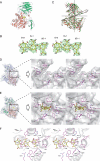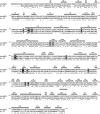Crystal structure of exotype alginate lyase Atu3025 from Agrobacterium tumefaciens
- PMID: 20507980
- PMCID: PMC2915688
- DOI: 10.1074/jbc.M110.125450
Crystal structure of exotype alginate lyase Atu3025 from Agrobacterium tumefaciens
Abstract
Alginate, a major component of the cell wall matrix in brown seaweeds, is degraded by alginate lyases through a beta-elimination reaction. Almost all alginate lyases act endolytically on substrate, thereby yielding unsaturated oligouronic acids having 4-deoxy-l-erythro-hex-4-enepyranosyluronic acid at the nonreducing end. In contrast, Agrobacterium tumefaciens alginate lyase Atu3025, a member of polysaccharide lyase family 15, acts on alginate polysaccharides and oligosaccharides exolytically and releases unsaturated monosaccharides from the substrate terminal. The crystal structures of Atu3025 and its inactive mutant in complex with alginate trisaccharide (H531A/DeltaGGG) were determined at 2.10- and 2.99-A resolutions with final R-factors of 18.3 and 19.9%, respectively, by x-ray crystallography. The enzyme is comprised of an alpha/alpha-barrel + anti-parallel beta-sheet as a basic scaffold, and its structural fold has not been seen in alginate lyases analyzed thus far. The structural analysis of H531A/DeltaGGG and subsequent site-directed mutagenesis studies proposed the enzyme reaction mechanism, with His(311) and Tyr(365) as the catalytic base and acid, respectively. Two structural determinants, i.e. a short alpha-helix in the central alpha/alpha-barrel domain and a conformational change at the interface between the central and C-terminal domains, are essential for the exolytic mode of action. This is, to our knowledge, the first report on the structure of the family 15 enzyme.
Figures





References
Publication types
MeSH terms
Substances
Associated data
- Actions
- Actions
LinkOut - more resources
Full Text Sources

